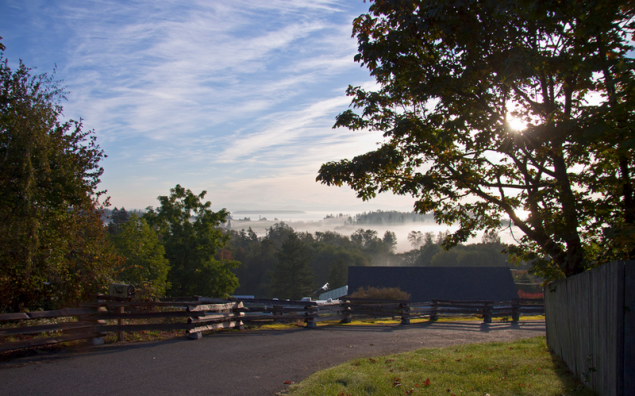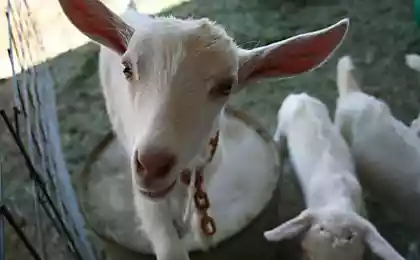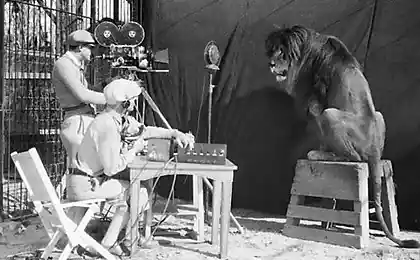648
Farm for life "MARK and the LION"
How to build a house, provide for your family organic products, but still make money? LavkaLavka and creators of Rustic restaurant "MARK and the LION" begin the project on creation of a Farm to life in the village Dvoryaninovo Zaoksky district of Tula region. It is time to tell the details of the project and how to join. What is it? First, this is the place for new life. A small eco-village with its farm, which will provide residents their own organic food. Food security is achieved through products, which are manufactured in accordance with all standards of organic agriculture. Second, this farm itself and the farmer's cooperative, consisting of 10-15 small farms, specializing in everything you can grow and produce in an average strip of Russia, from vegetables and fruits to milk, cheese, meat and sausages.
You can be not just a resident, but if you want a farmer the owner of a private farm directions: cheese maker, a rancher, or chief cook jam! So our village can be more than just a place to live, but also to give the opportunity to capitalize on the development of our own organic farming business.

Where is all this going to be? 100 km South of Moscow, in the Tula region beyond the river Oka. The district is called zaokskiy. It is the birthplace of the great Russian agronomist and "agricultural thinker", Andrei Timofeevich Bolotov. Moreover – field on the left Bank of the river Knigi where our cooperative grows wheat and potatoes, from the XVII century belonged to the landowners Bolotov.
In the XVII century on Snige was built dam, the water wheel which resulted in the movement the fur of metallurgical furnaces Kashira factories, at that time a very large and profitable enterprises. Part Bolotovskii fields flooded with water of the factory reservoir, and the landowners received for it from the manufacturers compensation. We are now reflecting on how to rebuild the dam and construct a mill on it.
Who is Andrei Timofeevich Bolotov? Andrei Timofeevich Bolotov (1738-1833) was the first Russian scientist-agronomist, writer, author of memoirs "the Life and adventures of Andrej Bolotov, described by them to their descendants." Largely due to Bolotov in Russia was recognized as the crops of tomatoes and potatoes. Born in Dvoryaninova. With 19 years he served in the Archangelsk regiment participated in the Seven years war. After retiring with the rank of captain, settled in the family estate. Collected extensive research library, published agricultural articles, published weekly "villager", 10 years, he led a large heading "Economic store" in the "Moscow Gazette", from the materials which amounted to 40-volume encyclopedia of agricultural.

In his capital work "On the division of the fields" (1771) Bolotov Russia's first print offered widely to enter the rotation, to determine the methods of cultivation of cultural plants, on the basis of local environmental conditions (especially weather and soil), advocated the timeliness and proportionality of fertilizer, even the black earth. That is largely determined the principles of modern organic agriculture.
These principles, labors and observations Bolotov nature native Dvoryaninova we are guided by planning the economic activity of the Farm for life "MARK and the LION".
How to participate in it?There are three ways to become a member of our cooperative Farm for life "MARK and the LION".
– You can buy yourself one of 50 houses on plots 9 to 15 acres. All parcels with utilities. House with a plot – from 2.5 million rubles. In addition, you become a member of the cooperative and receive the right to buy farm products from the farm at a price close to cost.
– You can become a farmer. Regardless of whether you buy a house in the village or not – you can invest in a farm area. Become the owner of the dairies, or grazing land. To get cows or sheep, to plant potatoes or asparagus. The extent of your participation in the farm business can be different – from total immersion and becoming a farmer to the position of the investor. In any case, you will be the owner of your farm and also a member of production agricultural cooperative, which will provide its members with technology, veterinary and agronomic services. And most importantly – sales. Thus, your farm will not just be a source of good food and fun, but also provide income.
– No matter where you live, you can join our cooperative and to buy manufactured products at a special co-op prices. This is especially important for all residents of Zaoksky district of Tula region and those who come here on vacation.
What about this? Boris Akimov about the new co-operative project of Lakalaka in Tula region: "in front of me on the table lies a map of the XVIII century. Dvoryaninovo the village and its surroundings. On this map – farmhouses and plots of land and landed estates, now existing. "Recrestional" Russia.
Lakalaka together with the cooperative "MARK and the LION" begins the project of colonization of empty villages. Instead of holiday villages, the inhabitants of which carry with them from Moscow full racks products from supermarkets, we will build a creative village that will generate (create) an excess of food.
Instead of endless farm fields sown with monoculture, we will create a space that produces 200 kinds of agricultural products and provides 95% of the festive table.
http://www.ntv.ru/video/embed/1014384
The NTV story about the farmer and the Nike Permyakova Farm for life "MARK and the LION".
We will tell everyone who wants to at least briefly escape from the bustle of the city, how to build a house, provide for his family's own ecological products, and still make money. How to become a farmer without leaving the city forever without burning a bridge".

Sunrise on the Oka river.

View Of The Oka.
Instead of holiday villages, the inhabitants of which carry with them from Moscow full racks products from supermarkets, we will build a creative village, which will create excess food. Who invented it and makes? Implement the project based on the seller's "MARK and the LION" and the farmer cooperative LavkaLavka. On account of the creators of the restaurant "MARK and the LION" complex "velegozh Park resort" of 19 contemporary villas on the banks of the Oka river, fishing club and restaurant of gifts of the nature "Olympia", a sports club (horse riding, tennis, beach volleyball, boat station), children's creative school Lev Durov, a nursery of ornamental and fruit plants, farm, edition of Russian estates, and more.
The cooperative LavkaLavka incorporates more than 100 farms throughout Russia. LavkaLavka is an online farm shop that has 5 retail stores in Moscow, 2 cafes and a great farmer's restaurant. LavkaLavka has developed the ideology and principles of work opened in the summer of 2014 the village restaurant "MARK and the LION" – the first restaurant lokatorsko Russia.
It LavkaLavka will, on the one hand, the main sales channel of the cooperative Farm for life "MARK and the LION". And on the other LavkaLavka is a center of knowledge and competence in the field of ecological agriculture. Experts "Lakilaki" are consultants on the creation of the farm life of the cooperative Farm for life "MARK and the LION".
What kind of houses we will build in the village? Architect Lena Makarova took as a basis the traditional village houses of the Tula edge of a gambrel roof and Scandinavian style, introduced in the local architecture of artist Vasily Polenov. Modern minimalist reading Lena was very convenient, simple, stylish and affordable one-storey house with an area of 156 sq m with a huge veranda and many choices for interior layout. The project proved to be very popular, for two years, has already built more than 30 homes. For a large family of actor Lev Konstantinovich Durov Lena added a second floor. Get a modern two-storey house with five bedrooms.

The house of the family of Lev Konstantinovich Durov. Architect Lena Makarova.
What are the rules of the common life will we have? All of our internal rules actually are purely external. In the sense that affect the appearance of our village. Because we respect each other, the facades of the houses and appearance of the village fences and settling perioperative only by mutual agreement. Fences made of profiled sheet will not be, as terrible terrible houses and palaces. We want our village was beautiful, but without compliance with some of the architectural rules is impossible. No wonder, when we come to Europe we admire the same style of towns and villages. We would like to and our Dvoryaninovo was cute and cozy place to live.
What kind of farm we want to build? Farm produces the maximum possible seasonal range of environmental products to provide the residents of co-op sales on the free market. Economic goal – to make the farm efficient business, generating a profit.
The farm is expected to produce the following products: milk and milk products, eggs, meat and poultry, sausage and deli meats, rabbit, fish, bread and bakery products, vegetables, fruits, berries, harvesting of vegetables, fruits, mushrooms and berries, canned goods, feed for farm animals.
The volume of products must meet the following criteria:
. to meet the demand of residents of the cooperative;
b. to do each of the areas efficient and profitable business.

For the development of these areas and the performance that we need, we should be guided about the following livestock, area and production capacity.
Something that can be owned by individual cooperative members(all lands under pastures and crops belong to the co-operative and are leased to a farmer):
– Beef. Cattle. 300-400 heads. 200-400 hectares under grain and pasture. Content in pastures and outdoor pens.
Pork. A herd of 400 heads, 4 sty. Exercise no. Forage base (vegetable and grains) – 20 ha.
– Mutton – 400 heads. Sheepfold – 3 PCs Pasture. 100 ha. of Forage (oats) – 20 hectares.
– Rabbits. 1000 heads. 1 hectare of land. Aviaries and cages.
The bird on the meat. Chickens (broilers) – 3000 livestock. Chicken coops – 3 PCs. for 100 sq. meters and a paddock of 30 acres each. Duck (500), aviary, paddock, pond – 50 acres, geese (300) – the house and the pasture of 3 hectares.
– A sausage shop. 100 square meters. And equipment.
– Eggs. 3000 of laying hens. 3 coop for 200 meters. The paddock of 40 acres each.
Milk. 60 heads. The barn is 500 metres away. Pasture and feed – 100 ha.
– Dairy products Dairy shop. 100 meters.
The cheese in the maturing of cheese.
– A bakery.
– Plant vegetable processing.
– Slaughterhouse for all animals.
– Cutting the meat shop with the camera exposure.
– Granary.
– Vegetable store.
– Refrigerated room for food storage.
– Tourism and educational programs. The hotel and venue of the seminars.
Something that can be owned by the entire cooperative.
– House for staff – 150 m.
Office, storage room veterinary drugs and things that will be required for sanitary and other requirements.
– Machinery for land cultivation and harvesting. 2 tractors, combine, other sheds etc.
– The area under vegetables, fruits and berries.
– The area under cereals – 100 ha.
– The area under pastures – 500 ha.
The total area of all pastures and fields under crops – about 1000 hectares.
If you do not consider pastures and crops under all other production needs about 50-100 ha.
Which staff members are in the co-op? — tractor-combine
veterinarian
agronomist
— livestock
— managing
Manager sales
— working.
You will also need the services of a management company: accountant, lawyer, marketer, IT, health officer, experts in the field of ekoprominvest products, construction specialists, etc. In many of these areas you can get grants, grants from the state and preferential loans.


How will this work? Each direction is allocated in a separate business plan and each can be one or more investors, farmers members of the cooperative. Example. "I join the co-op and choose cheese as your business. Give the money and the desire itself is involved in this case. This will be my diary. In private ownership. But I will get milk from another member of the cooperative. Milk I need quality. And have the cooperative distribution channels, providing me with all the agricultural skills, accounting, legal and other support. That is, the cooperative for me to do all I can just to make a good cheese."

Each discipline has owner. The farmer-owner. But it cannot exist without the other, without the cooperative, which gives every possible opportunity for survival and growth. That is, all production is sold in the property. Or built by the owners. The ground beneath them is also in their ownership. And the fields under crop production, grains, grazing in the common property of the cooperative. This will save all co-operative members from the risk that the individual member of the cooperative sell the land and deprive the rest of the important means of the total production. In addition, the property of the cooperative must be such a thing as MTS and all that is an important place "in common use".published
P. S. And remember, only by changing their consumption — together we change the world! ©
Join us in Facebook and in Vkontakte, and we're Classmates
Source: lavkagazeta.com/ekologiya/ferma-dlya-zhizni-mark-i-lev
You can be not just a resident, but if you want a farmer the owner of a private farm directions: cheese maker, a rancher, or chief cook jam! So our village can be more than just a place to live, but also to give the opportunity to capitalize on the development of our own organic farming business.

Where is all this going to be? 100 km South of Moscow, in the Tula region beyond the river Oka. The district is called zaokskiy. It is the birthplace of the great Russian agronomist and "agricultural thinker", Andrei Timofeevich Bolotov. Moreover – field on the left Bank of the river Knigi where our cooperative grows wheat and potatoes, from the XVII century belonged to the landowners Bolotov.
In the XVII century on Snige was built dam, the water wheel which resulted in the movement the fur of metallurgical furnaces Kashira factories, at that time a very large and profitable enterprises. Part Bolotovskii fields flooded with water of the factory reservoir, and the landowners received for it from the manufacturers compensation. We are now reflecting on how to rebuild the dam and construct a mill on it.
Who is Andrei Timofeevich Bolotov? Andrei Timofeevich Bolotov (1738-1833) was the first Russian scientist-agronomist, writer, author of memoirs "the Life and adventures of Andrej Bolotov, described by them to their descendants." Largely due to Bolotov in Russia was recognized as the crops of tomatoes and potatoes. Born in Dvoryaninova. With 19 years he served in the Archangelsk regiment participated in the Seven years war. After retiring with the rank of captain, settled in the family estate. Collected extensive research library, published agricultural articles, published weekly "villager", 10 years, he led a large heading "Economic store" in the "Moscow Gazette", from the materials which amounted to 40-volume encyclopedia of agricultural.

In his capital work "On the division of the fields" (1771) Bolotov Russia's first print offered widely to enter the rotation, to determine the methods of cultivation of cultural plants, on the basis of local environmental conditions (especially weather and soil), advocated the timeliness and proportionality of fertilizer, even the black earth. That is largely determined the principles of modern organic agriculture.
These principles, labors and observations Bolotov nature native Dvoryaninova we are guided by planning the economic activity of the Farm for life "MARK and the LION".
How to participate in it?There are three ways to become a member of our cooperative Farm for life "MARK and the LION".
– You can buy yourself one of 50 houses on plots 9 to 15 acres. All parcels with utilities. House with a plot – from 2.5 million rubles. In addition, you become a member of the cooperative and receive the right to buy farm products from the farm at a price close to cost.
– You can become a farmer. Regardless of whether you buy a house in the village or not – you can invest in a farm area. Become the owner of the dairies, or grazing land. To get cows or sheep, to plant potatoes or asparagus. The extent of your participation in the farm business can be different – from total immersion and becoming a farmer to the position of the investor. In any case, you will be the owner of your farm and also a member of production agricultural cooperative, which will provide its members with technology, veterinary and agronomic services. And most importantly – sales. Thus, your farm will not just be a source of good food and fun, but also provide income.
– No matter where you live, you can join our cooperative and to buy manufactured products at a special co-op prices. This is especially important for all residents of Zaoksky district of Tula region and those who come here on vacation.
What about this? Boris Akimov about the new co-operative project of Lakalaka in Tula region: "in front of me on the table lies a map of the XVIII century. Dvoryaninovo the village and its surroundings. On this map – farmhouses and plots of land and landed estates, now existing. "Recrestional" Russia.
Lakalaka together with the cooperative "MARK and the LION" begins the project of colonization of empty villages. Instead of holiday villages, the inhabitants of which carry with them from Moscow full racks products from supermarkets, we will build a creative village that will generate (create) an excess of food.
Instead of endless farm fields sown with monoculture, we will create a space that produces 200 kinds of agricultural products and provides 95% of the festive table.
http://www.ntv.ru/video/embed/1014384
The NTV story about the farmer and the Nike Permyakova Farm for life "MARK and the LION".
We will tell everyone who wants to at least briefly escape from the bustle of the city, how to build a house, provide for his family's own ecological products, and still make money. How to become a farmer without leaving the city forever without burning a bridge".

Sunrise on the Oka river.

View Of The Oka.
Instead of holiday villages, the inhabitants of which carry with them from Moscow full racks products from supermarkets, we will build a creative village, which will create excess food. Who invented it and makes? Implement the project based on the seller's "MARK and the LION" and the farmer cooperative LavkaLavka. On account of the creators of the restaurant "MARK and the LION" complex "velegozh Park resort" of 19 contemporary villas on the banks of the Oka river, fishing club and restaurant of gifts of the nature "Olympia", a sports club (horse riding, tennis, beach volleyball, boat station), children's creative school Lev Durov, a nursery of ornamental and fruit plants, farm, edition of Russian estates, and more.
The cooperative LavkaLavka incorporates more than 100 farms throughout Russia. LavkaLavka is an online farm shop that has 5 retail stores in Moscow, 2 cafes and a great farmer's restaurant. LavkaLavka has developed the ideology and principles of work opened in the summer of 2014 the village restaurant "MARK and the LION" – the first restaurant lokatorsko Russia.
It LavkaLavka will, on the one hand, the main sales channel of the cooperative Farm for life "MARK and the LION". And on the other LavkaLavka is a center of knowledge and competence in the field of ecological agriculture. Experts "Lakilaki" are consultants on the creation of the farm life of the cooperative Farm for life "MARK and the LION".
What kind of houses we will build in the village? Architect Lena Makarova took as a basis the traditional village houses of the Tula edge of a gambrel roof and Scandinavian style, introduced in the local architecture of artist Vasily Polenov. Modern minimalist reading Lena was very convenient, simple, stylish and affordable one-storey house with an area of 156 sq m with a huge veranda and many choices for interior layout. The project proved to be very popular, for two years, has already built more than 30 homes. For a large family of actor Lev Konstantinovich Durov Lena added a second floor. Get a modern two-storey house with five bedrooms.

The house of the family of Lev Konstantinovich Durov. Architect Lena Makarova.
What are the rules of the common life will we have? All of our internal rules actually are purely external. In the sense that affect the appearance of our village. Because we respect each other, the facades of the houses and appearance of the village fences and settling perioperative only by mutual agreement. Fences made of profiled sheet will not be, as terrible terrible houses and palaces. We want our village was beautiful, but without compliance with some of the architectural rules is impossible. No wonder, when we come to Europe we admire the same style of towns and villages. We would like to and our Dvoryaninovo was cute and cozy place to live.
What kind of farm we want to build? Farm produces the maximum possible seasonal range of environmental products to provide the residents of co-op sales on the free market. Economic goal – to make the farm efficient business, generating a profit.
The farm is expected to produce the following products: milk and milk products, eggs, meat and poultry, sausage and deli meats, rabbit, fish, bread and bakery products, vegetables, fruits, berries, harvesting of vegetables, fruits, mushrooms and berries, canned goods, feed for farm animals.
The volume of products must meet the following criteria:
. to meet the demand of residents of the cooperative;
b. to do each of the areas efficient and profitable business.

For the development of these areas and the performance that we need, we should be guided about the following livestock, area and production capacity.
Something that can be owned by individual cooperative members(all lands under pastures and crops belong to the co-operative and are leased to a farmer):
– Beef. Cattle. 300-400 heads. 200-400 hectares under grain and pasture. Content in pastures and outdoor pens.
Pork. A herd of 400 heads, 4 sty. Exercise no. Forage base (vegetable and grains) – 20 ha.
– Mutton – 400 heads. Sheepfold – 3 PCs Pasture. 100 ha. of Forage (oats) – 20 hectares.
– Rabbits. 1000 heads. 1 hectare of land. Aviaries and cages.
The bird on the meat. Chickens (broilers) – 3000 livestock. Chicken coops – 3 PCs. for 100 sq. meters and a paddock of 30 acres each. Duck (500), aviary, paddock, pond – 50 acres, geese (300) – the house and the pasture of 3 hectares.
– A sausage shop. 100 square meters. And equipment.
– Eggs. 3000 of laying hens. 3 coop for 200 meters. The paddock of 40 acres each.
Milk. 60 heads. The barn is 500 metres away. Pasture and feed – 100 ha.
– Dairy products Dairy shop. 100 meters.
The cheese in the maturing of cheese.
– A bakery.
– Plant vegetable processing.
– Slaughterhouse for all animals.
– Cutting the meat shop with the camera exposure.
– Granary.
– Vegetable store.
– Refrigerated room for food storage.
– Tourism and educational programs. The hotel and venue of the seminars.
Something that can be owned by the entire cooperative.
– House for staff – 150 m.
Office, storage room veterinary drugs and things that will be required for sanitary and other requirements.
– Machinery for land cultivation and harvesting. 2 tractors, combine, other sheds etc.
– The area under vegetables, fruits and berries.
– The area under cereals – 100 ha.
– The area under pastures – 500 ha.
The total area of all pastures and fields under crops – about 1000 hectares.
If you do not consider pastures and crops under all other production needs about 50-100 ha.
Which staff members are in the co-op? — tractor-combine
veterinarian
agronomist
— livestock
— managing
Manager sales
— working.
You will also need the services of a management company: accountant, lawyer, marketer, IT, health officer, experts in the field of ekoprominvest products, construction specialists, etc. In many of these areas you can get grants, grants from the state and preferential loans.


How will this work? Each direction is allocated in a separate business plan and each can be one or more investors, farmers members of the cooperative. Example. "I join the co-op and choose cheese as your business. Give the money and the desire itself is involved in this case. This will be my diary. In private ownership. But I will get milk from another member of the cooperative. Milk I need quality. And have the cooperative distribution channels, providing me with all the agricultural skills, accounting, legal and other support. That is, the cooperative for me to do all I can just to make a good cheese."

Each discipline has owner. The farmer-owner. But it cannot exist without the other, without the cooperative, which gives every possible opportunity for survival and growth. That is, all production is sold in the property. Or built by the owners. The ground beneath them is also in their ownership. And the fields under crop production, grains, grazing in the common property of the cooperative. This will save all co-operative members from the risk that the individual member of the cooperative sell the land and deprive the rest of the important means of the total production. In addition, the property of the cooperative must be such a thing as MTS and all that is an important place "in common use".published
P. S. And remember, only by changing their consumption — together we change the world! ©
Join us in Facebook and in Vkontakte, and we're Classmates
Source: lavkagazeta.com/ekologiya/ferma-dlya-zhizni-mark-i-lev
Top 10 nature videos shot with drones
The story of how scientists searched for it in the mind of the journalist




















